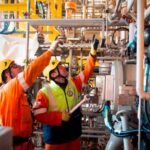Subsea Micropiles has made a significant leap in offshore wind technology by installing its innovative micropile anchor solution for Orkney Harbour Authority (OHA) in Scotland. This major milestone marks a significant advancement in the development of offshore wind infrastructure, combining cutting-edge technology with sustainable practices.
Revolutionizing Offshore Wind Foundations
Micropiling technology, once primarily used in land-based applications, has now been adapted for offshore use, offering an innovative solution for both floating and bottom-fixed offshore wind projects. Subsea Micropiles’ new anchor design promises to be a game-changer in the offshore wind industry, with the potential to make large construction jobs more cost-effective, environmentally friendly, and scalable.
This adaptation of micropiling technology follows more than $13 million in research and development (R&D), resulting in a commercial drilled and grouted micropile anchor system that has been successfully installed in Scotland. The technology aims to improve the efficiency of offshore wind foundations, a crucial component in the rapidly growing renewable energy sector.

Low-Cost, Environmentally Friendly Solution
One of the key benefits of Subsea Micropiles’ new approach is the use of smaller vessels and remote seabed drilling systems, which can perform large-scale offshore construction work at a fraction of the cost of traditional methods. The company claims this solution significantly reduces environmental impact while boosting local content, a crucial element in sustainable development.
By employing smaller vessels, which require less fuel and manpower, the company reduces carbon emissions, contributing to a greener, more eco-friendly offshore construction process. The ability to drill and grout micropiles remotely also means that the technology can be deployed in challenging offshore environments without the need for costly and disruptive offshore platforms.
A Scalable Solution for Floating Offshore Wind
The micropile anchor solution is specifically designed to support both fixed and floating offshore wind structures. This flexibility makes the technology an ideal solution for the rapidly expanding offshore wind industry, where projects must often be adaptable to a wide range of sea conditions and load requirements.
The foundation designs offered by Subsea Micropiles can be customized to handle high-load conditions, ensuring that the solution works across various soil types and seabed structures. As floating offshore wind farms become more prevalent, particularly in regions like Scotland, the ability to adapt micropile technology to these conditions is a significant step forward in achieving renewable energy goals.
Supporting Innovation and Local Partnerships
The installation of the first commercial micropile anchor in Scotland is a major achievement for both Subsea Micropiles and Orkney Harbour Authority. Jim Buck, the Harbourmaster at OHA, expressed excitement at becoming an early adopter of this new technology: “The Orkney Harbour Authority is pleased to become an ‘early adopter’ in order to support innovation like this in the marine industry – and we will now explore opportunities for its use, whether that be as a mooring point for our tug fleet or uses around offshore wind in the future.”
OHA’s involvement in this project highlights the importance of collaboration between local authorities, innovation-driven companies, and renewable energy stakeholders. As an early adopter, OHA is positioning itself at the forefront of marine industry innovation, with a focus on leveraging local resources to support the growth of offshore wind.
Innovation That Could Shape the Future of Offshore Wind
Derek Robertson, CEO of Subsea Micropiles, reflected on the company’s pioneering efforts in developing this new technology: “I am very proud to recognize the pioneering achievements of our team who are introducing a full-solution and service capability to the market.” Robertson also acknowledged the support from key partners such as Mincon, which helped develop the subsea drilling equipment and highly productive drilling technology necessary for the micropile anchor solution.
The installation of this micropile anchor is just the beginning. Subsea Micropiles plans to expand its technology’s applications, particularly in the floating offshore wind sector, which has the potential to reshape the renewable energy landscape. As more countries and industries turn to offshore wind for clean energy solutions, this technology could play a crucial role in helping meet energy demands while minimizing environmental impact.


















